15+ Timeless Brick Edging Ideas To Enhance Your Walkway
Are you looking to elevate your outdoor space and make it truly exceptional? Brick edging ideas can be a game-changer, providing both form and function. Not only does it serve as a practical boundary marker, but it also adds a touch of sophistication and visual appeal to your garden. With its clean lines and defined borders, brick edging helps keep your garden beds tidy and your grass from encroaching. This is especially true when compared to the more haphazard look of mulch or gravel.
But bricks aren’t just about utility; they can be arranged in a multitude of ways to match your personal style, whether you’re aiming for rustic charm or modern sleekness. In this article, we’ll explore 15 creative ways to use brick edging to take your garden to the next level. From classic straight lines to intricate patterns and innovative combinations with other materials, these ideas will not only boost your garden’s functionality but also its curb appeal.
Brick Edging Ideas
Classic Straight-Line Brick Edging
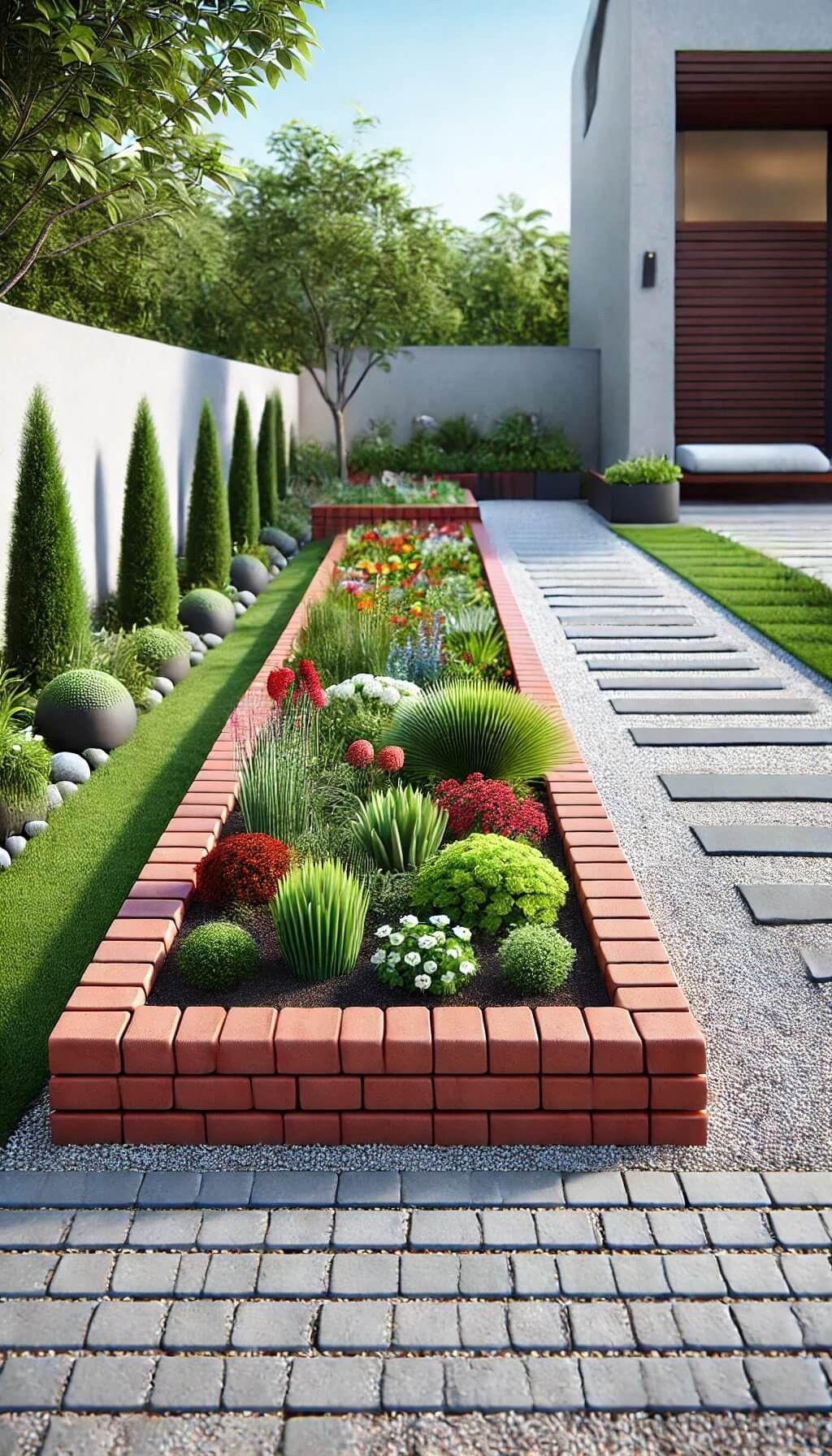
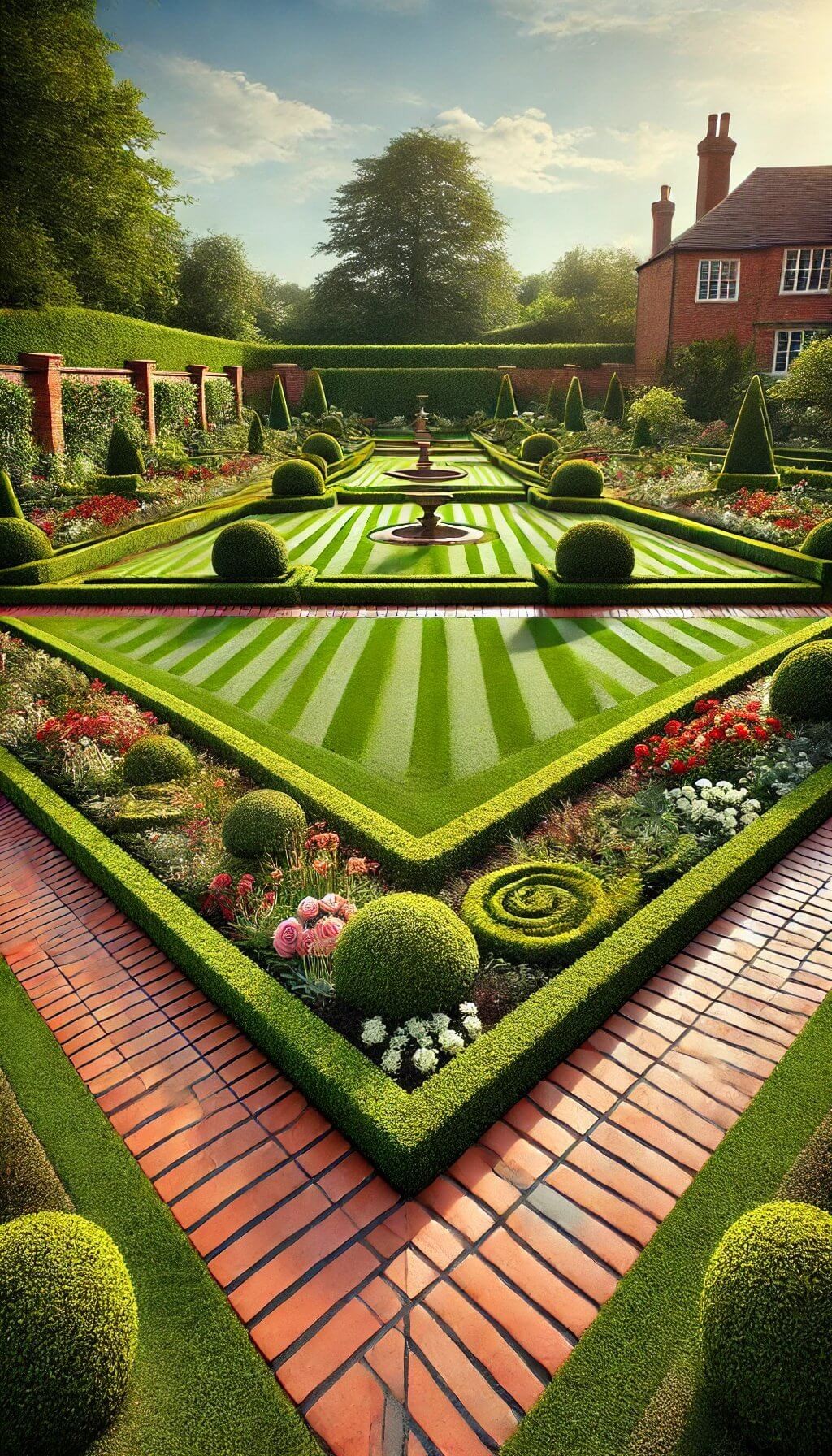
Straight-line brick edging may seem deceptively simple, but its understated elegance can have a profound impact on the aesthetic of your outdoor space. Its clean lines and tidy appearance make it an ideal choice for those who appreciate a well-manicured look.
To achieve this style, you’ll need just three essential components: bricks, sand, and a bit of elbow grease.
With a weekend at your disposal, simply lay your bricks in a straight line, ensuring each one is carefully positioned to snug up against the next.
This straightforward yet effective design approach lends itself beautifully to both minimalist and formal gardens, where its crisp edges can add a touch of sophistication. Its unassuming charm also makes it an excellent choice for those who prioritize organization and a sense of order in their outdoor spaces.
Curved Brick Edging

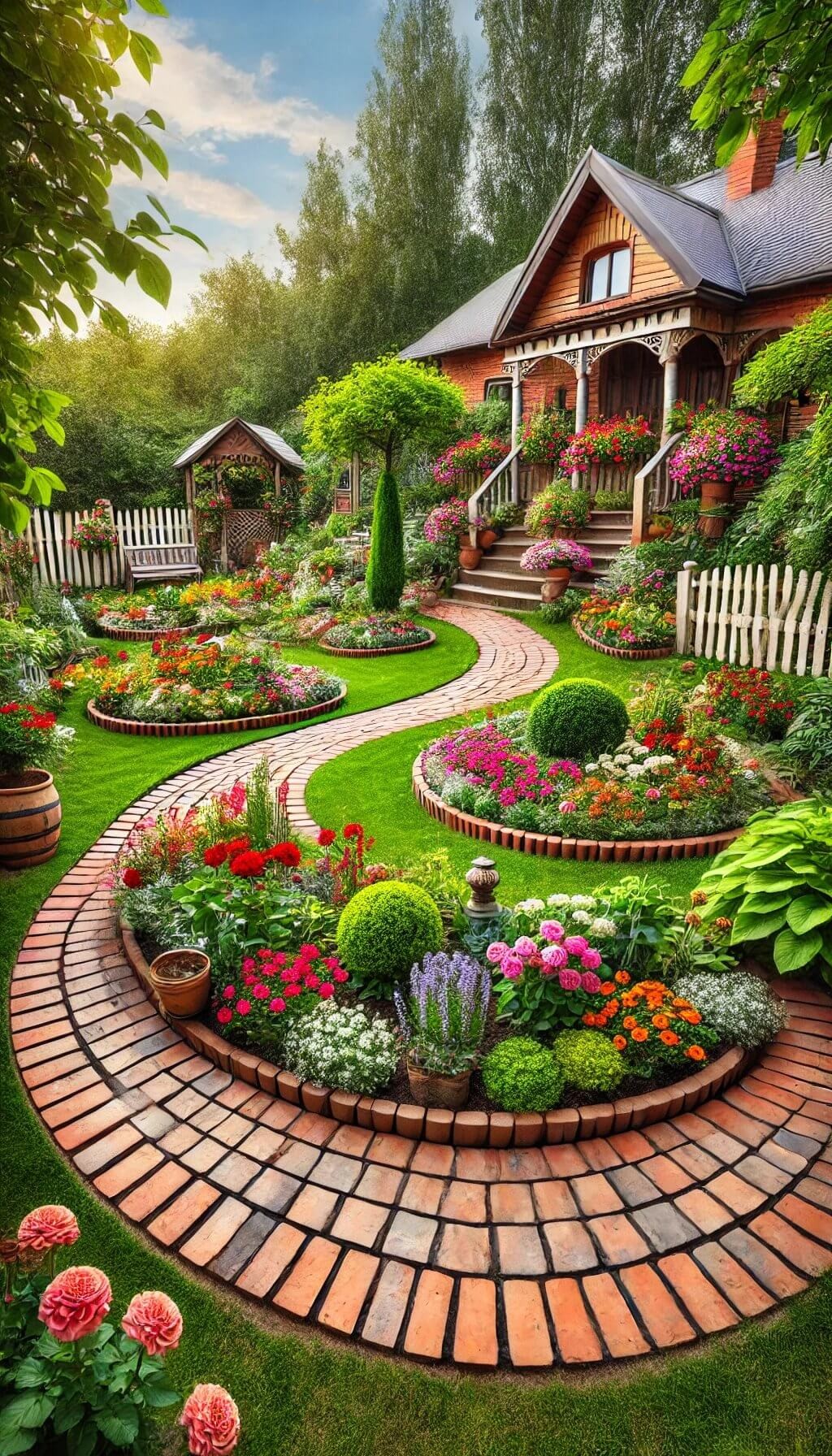
Imagine a serene river of bricks meandering through your garden, its curved path evoking a sense of natural elegance. Curved brick edging is a showstopping feature that adds visual interest to gardens with organic shapes and curves. While setting up this pattern may seem like solving a puzzle, the key is to lay your bricks loosely at first to achieve the desired curve before securing them in sand.
This unique design approach lets you ‘draw’ with bricks, creating a charming focal point in cottage-style or relaxed garden settings.
Raised Brick Edging
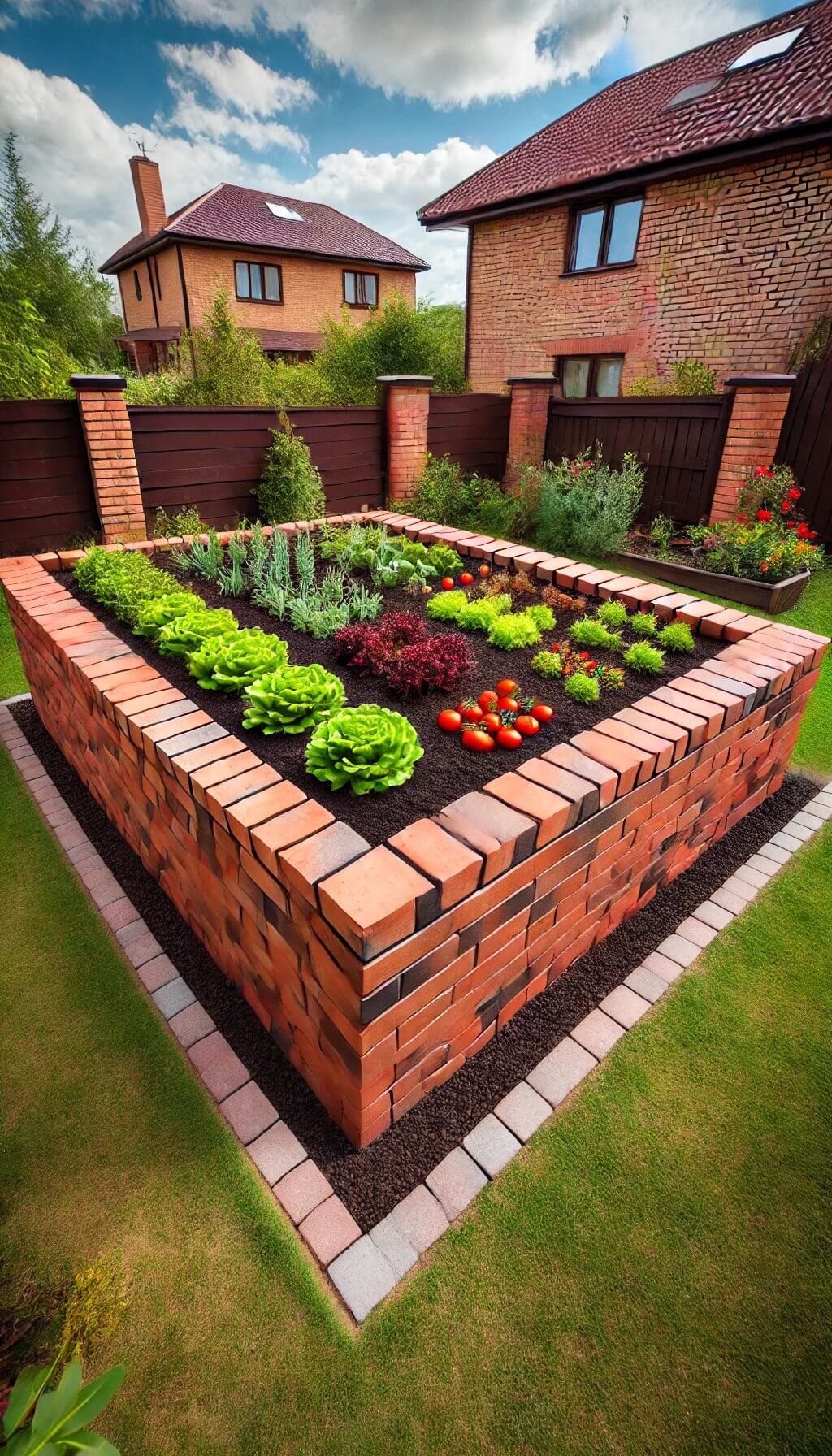
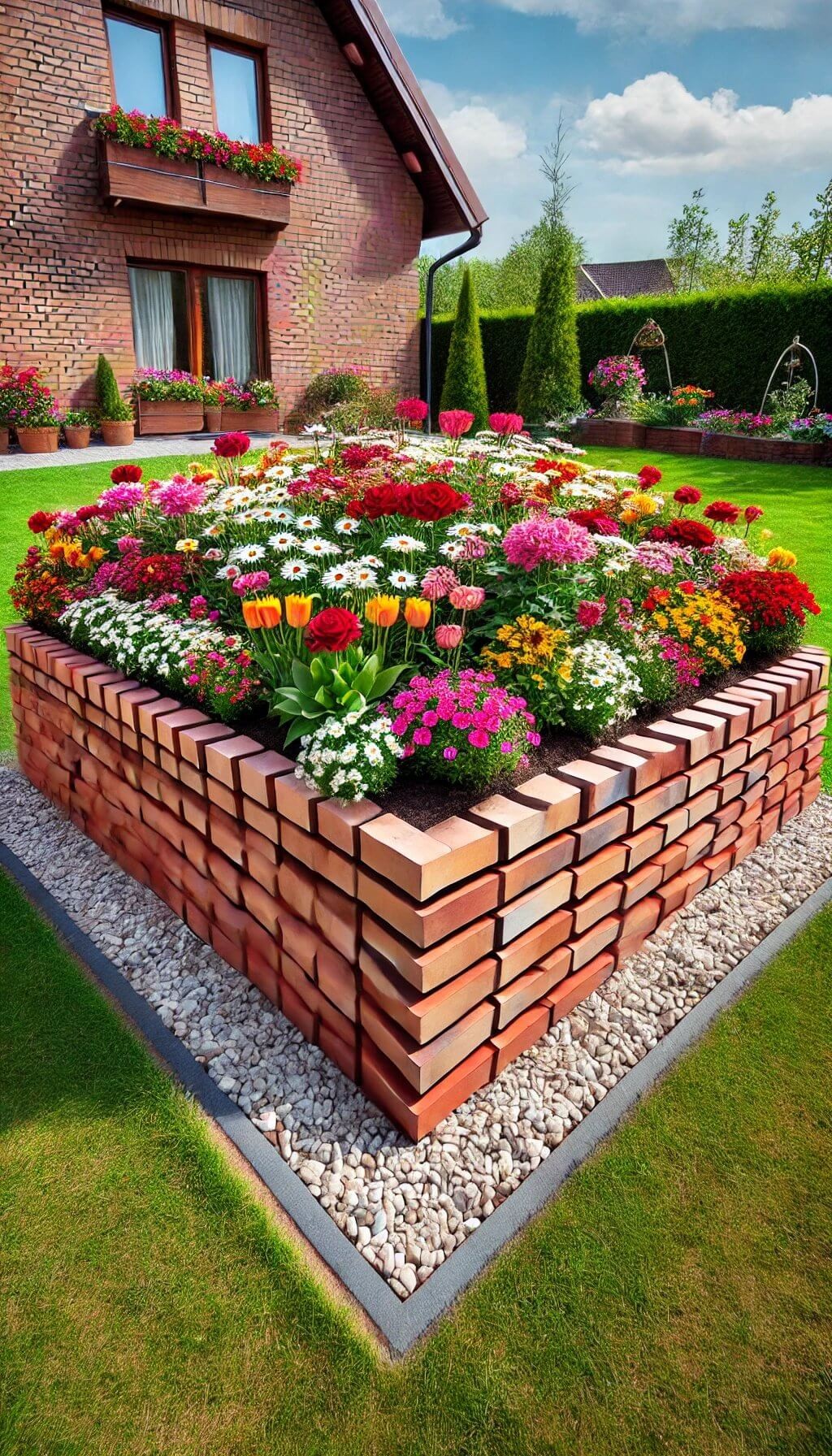
For those who crave a dash of drama in their outdoor space, consider incorporating raised brick edging into your garden design. This clever feature elevates your garden beds, transforming them into the focal point of your backyard oasis.
Not only does it add depth and visual interest to the space, but it also reduces the need for stooping down when planting or weeding, making it a practical choice as well.
With just a few simple tools – including bricks, a shovel, and perhaps some helpful hands – you can create a striking border that adds style and sophistication to your veggie patch or flower bed.
Whether you’re looking to add a touch of drama to your garden design or simply seeking a low-maintenance solution for your outdoor space, raised brick edging is an excellent choice.
Herringbone Pattern Edging
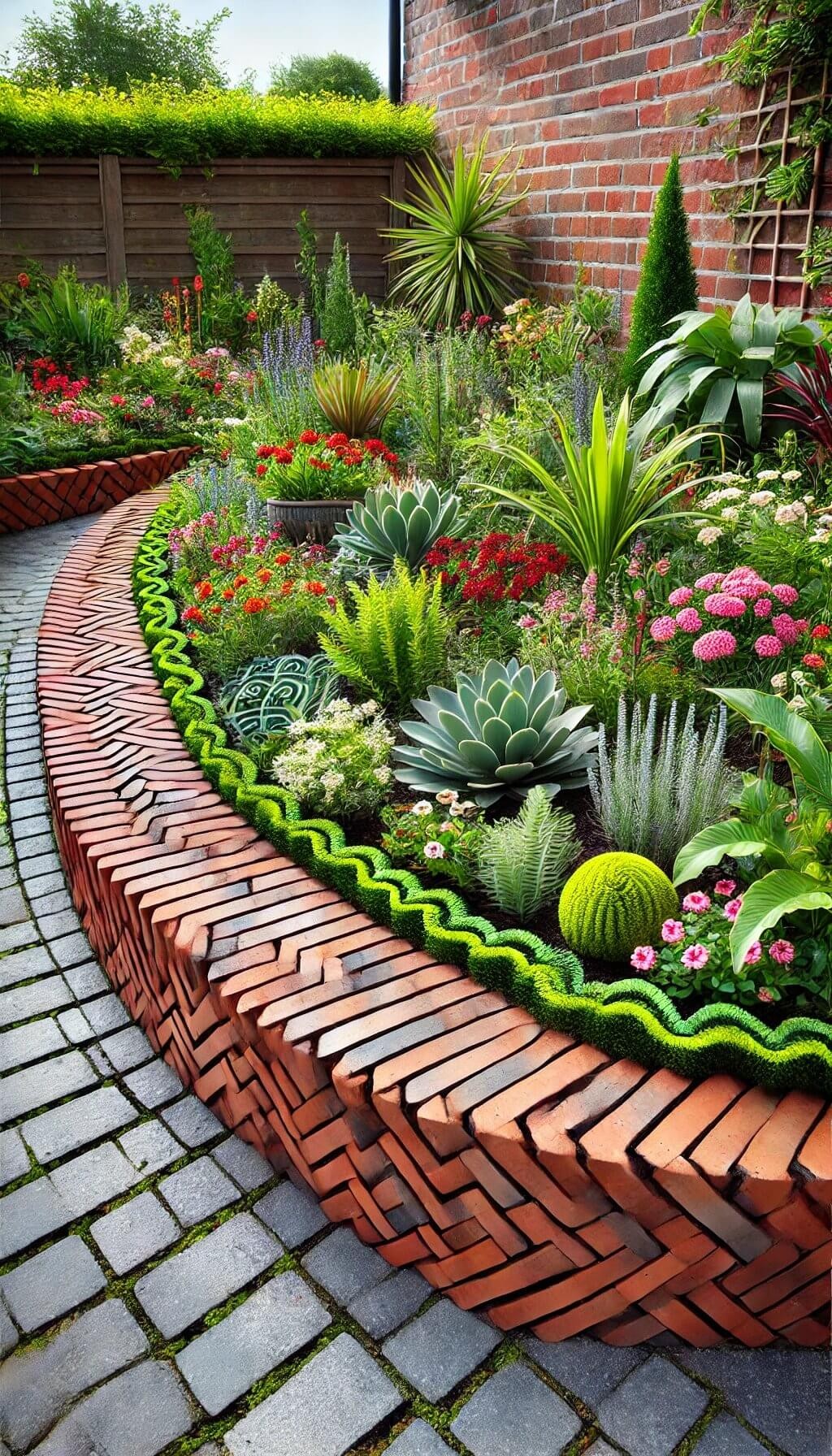
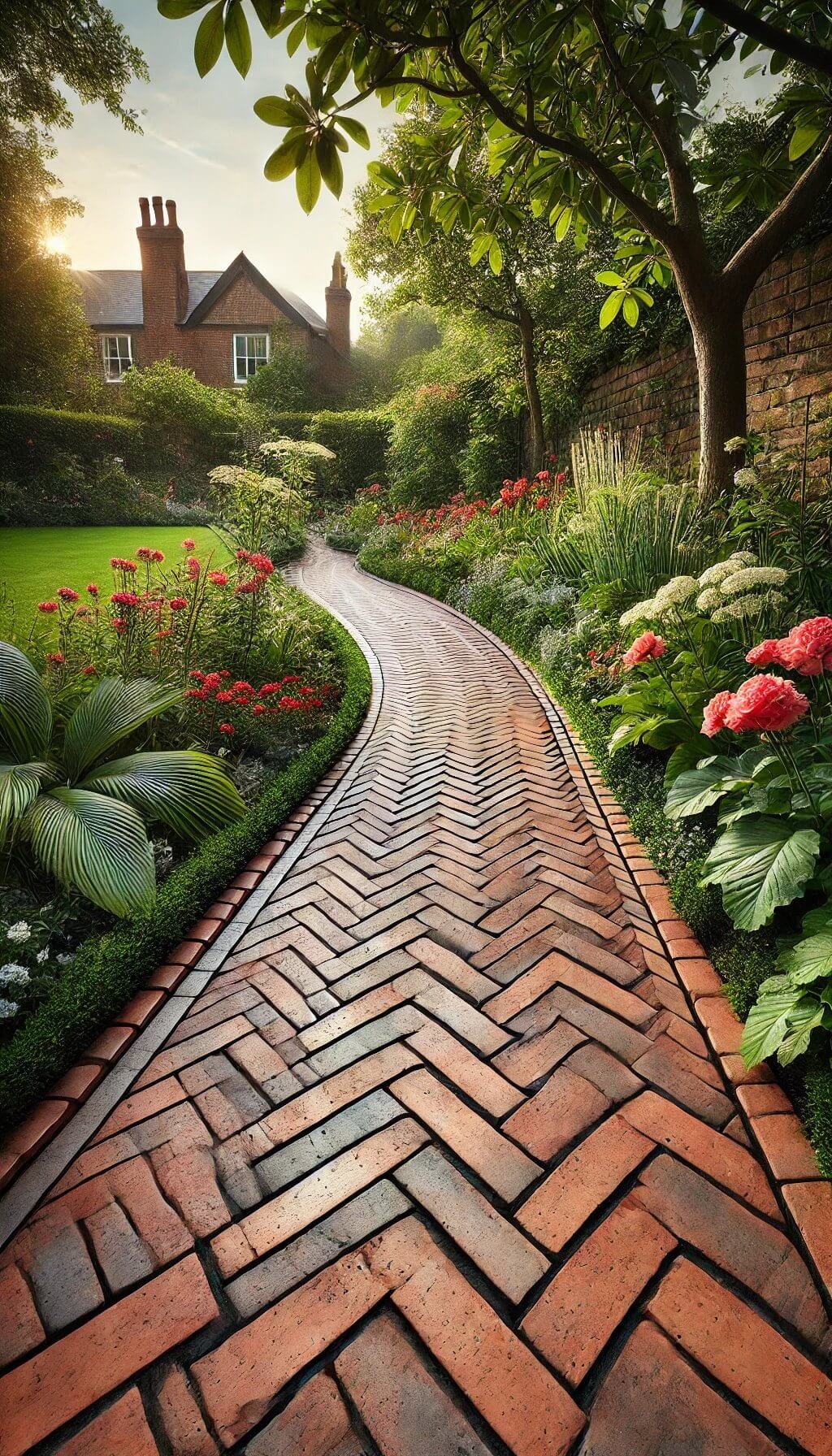
The herringbone pattern edging is a showstopper, thanks to its intricate design and dynamic angle. Its visual impact is undeniable, making it an excellent choice for both pathways and garden borders. While laying these bricks might be a challenging puzzle-like experience, the end result is well worth the effort.
This style requires patience and precision – think of it as carefully assembling a jigsaw puzzle where every piece must fit perfectly into place.
If you have a keen eye for detail and appreciate patterns that truly pop, this edging style is sure to suit your tastes.
Stacked Brick Edging
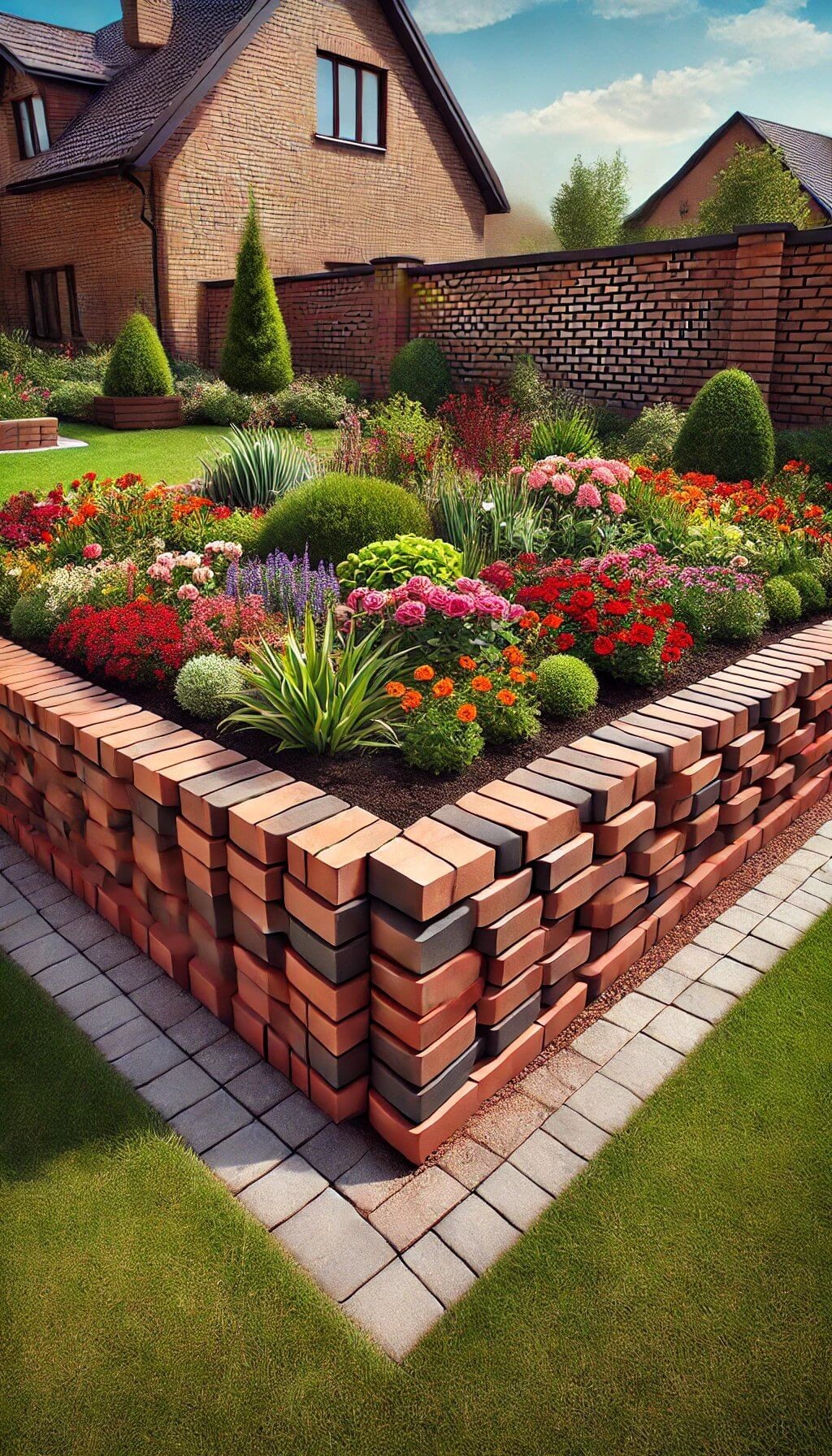

Creating a stacked brick edging around your garden beds is akin to constructing a miniature fortress, resulting in a striking three-dimensional border that commands attention. The advantages are twofold: the structure is remarkably sturdy, and it adds a bold visual touch to your outdoor space. However, this method does require more bricks and effort compared to other options. To ensure stability, place each brick so that it slightly overlaps the one beneath, much like building a small wall.
When executed correctly, this design will withstand the test of time and infuse your garden with a dash of personality.
Brick and Gravel Combination Edging
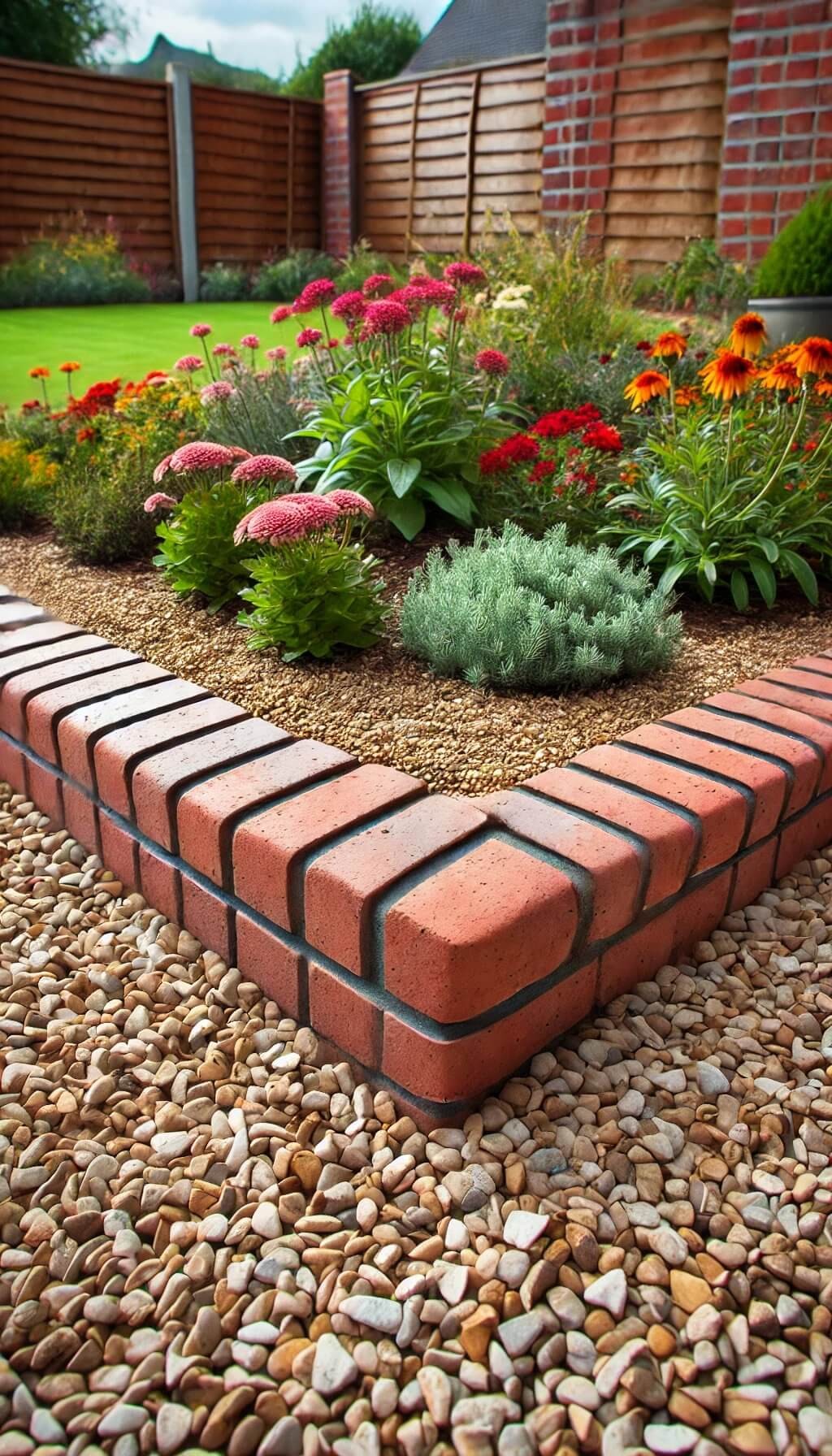
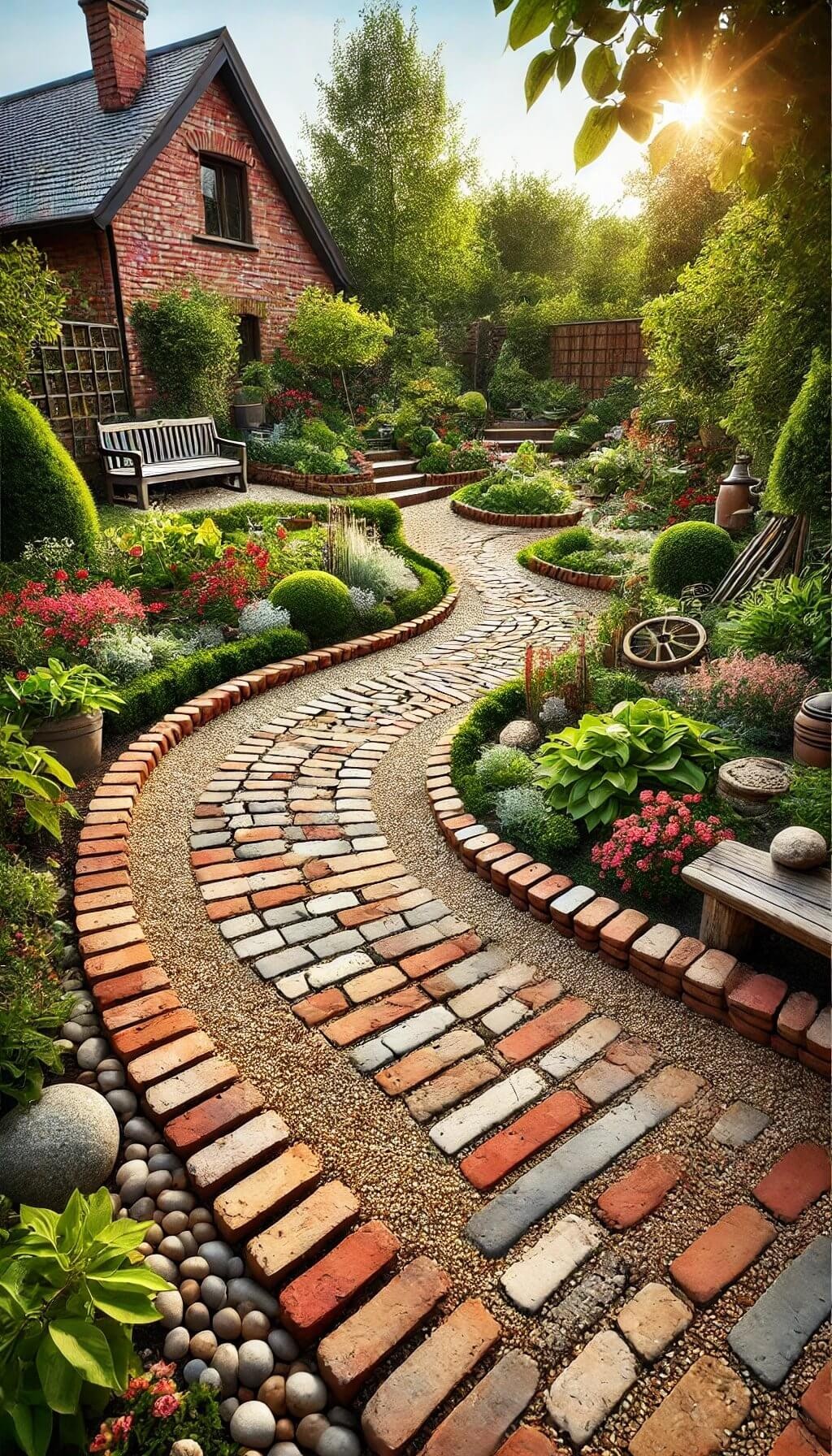
Blending bricks and gravel creates a unique visual effect that combines texture and color for a stylish outcome. The approach is straightforward: start by creating a neat border using the bricks, then fill in behind them with a layer of gravel. This harmonious combination not only pleases the eye but also proves to be budget-friendly and low-maintenance. Simply rake the gravel periodically to keep it looking tidy.
This aesthetic appeals to those who appreciate the rustic charm of natural materials alongside clean lines and a touch of modernity.
Brick and Concrete Edging
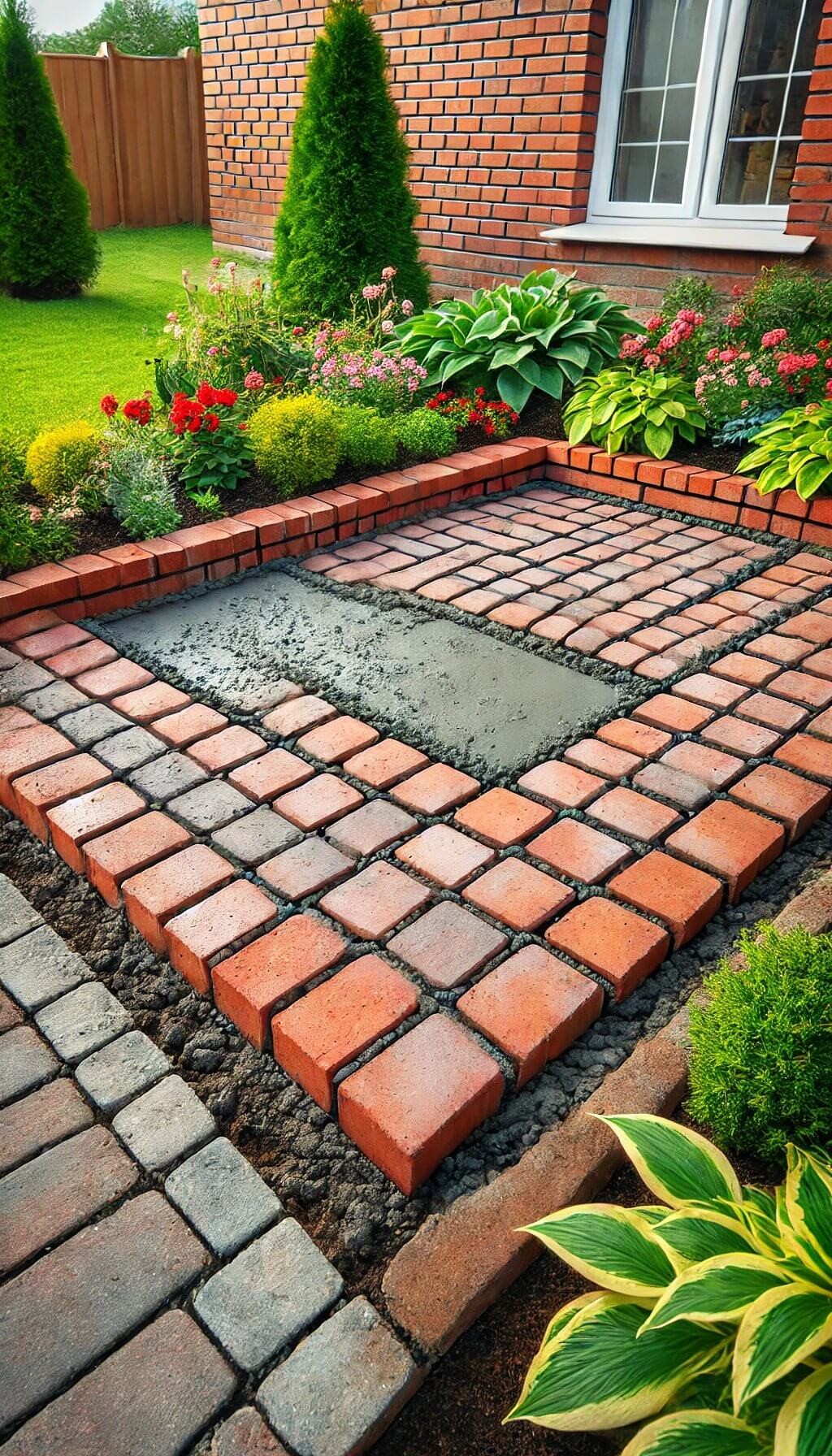
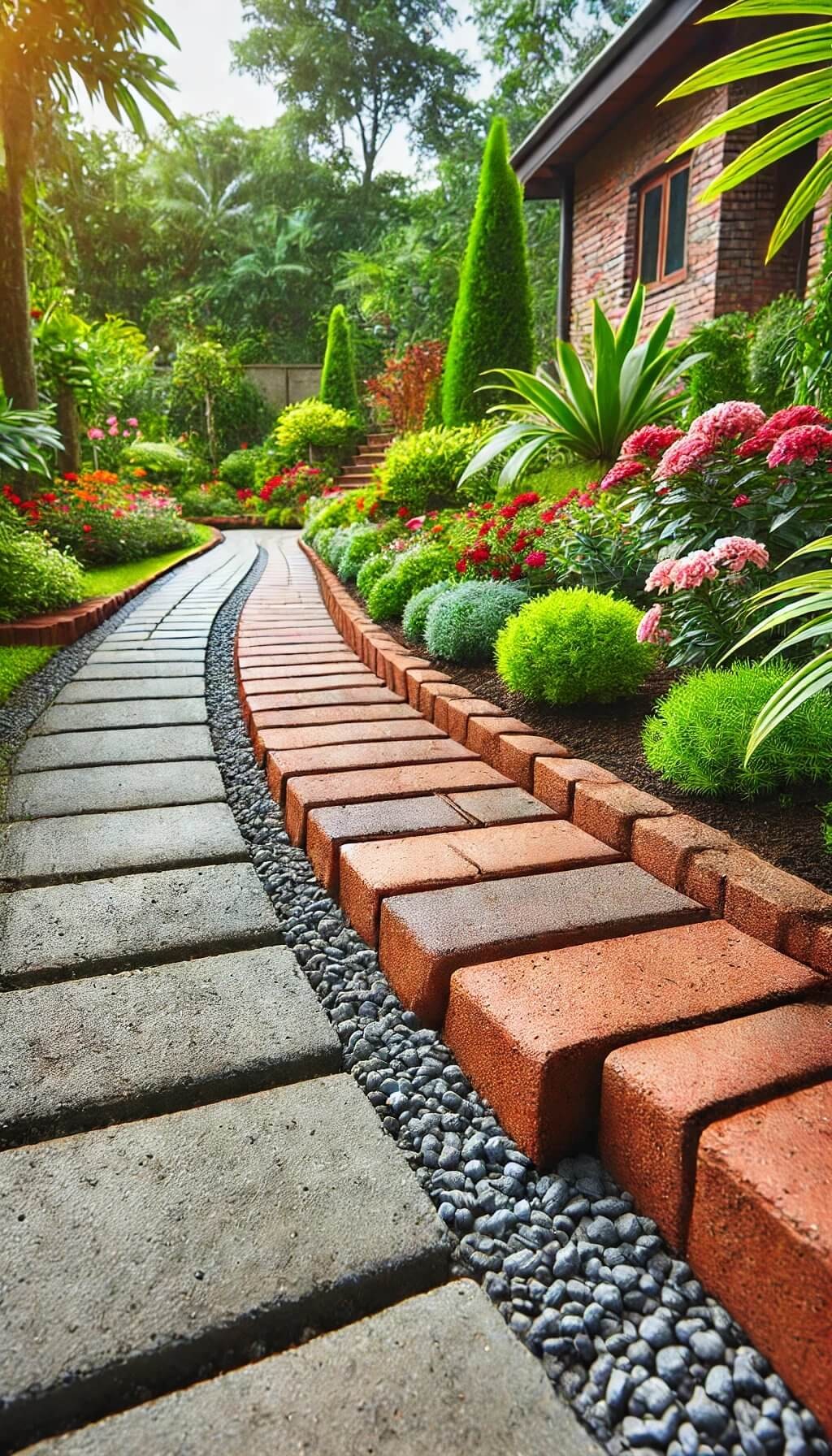
When it comes to creating a durable and long-lasting edging solution, combining brick and concrete can be a game-changer. By laying your bricks in the desired shape and then pouring concrete between them to secure them in place, you’ll end up with a border that’s remarkably resilient. While this approach may require a bit more effort upfront, the payoff is well worth it, as it’s perfect for areas that receive heavy foot traffic or are exposed to intense rainfall.
Just be sure to keep an eye out for any cracks that may develop in the concrete over time.
Brick Edging with Flower Inserts
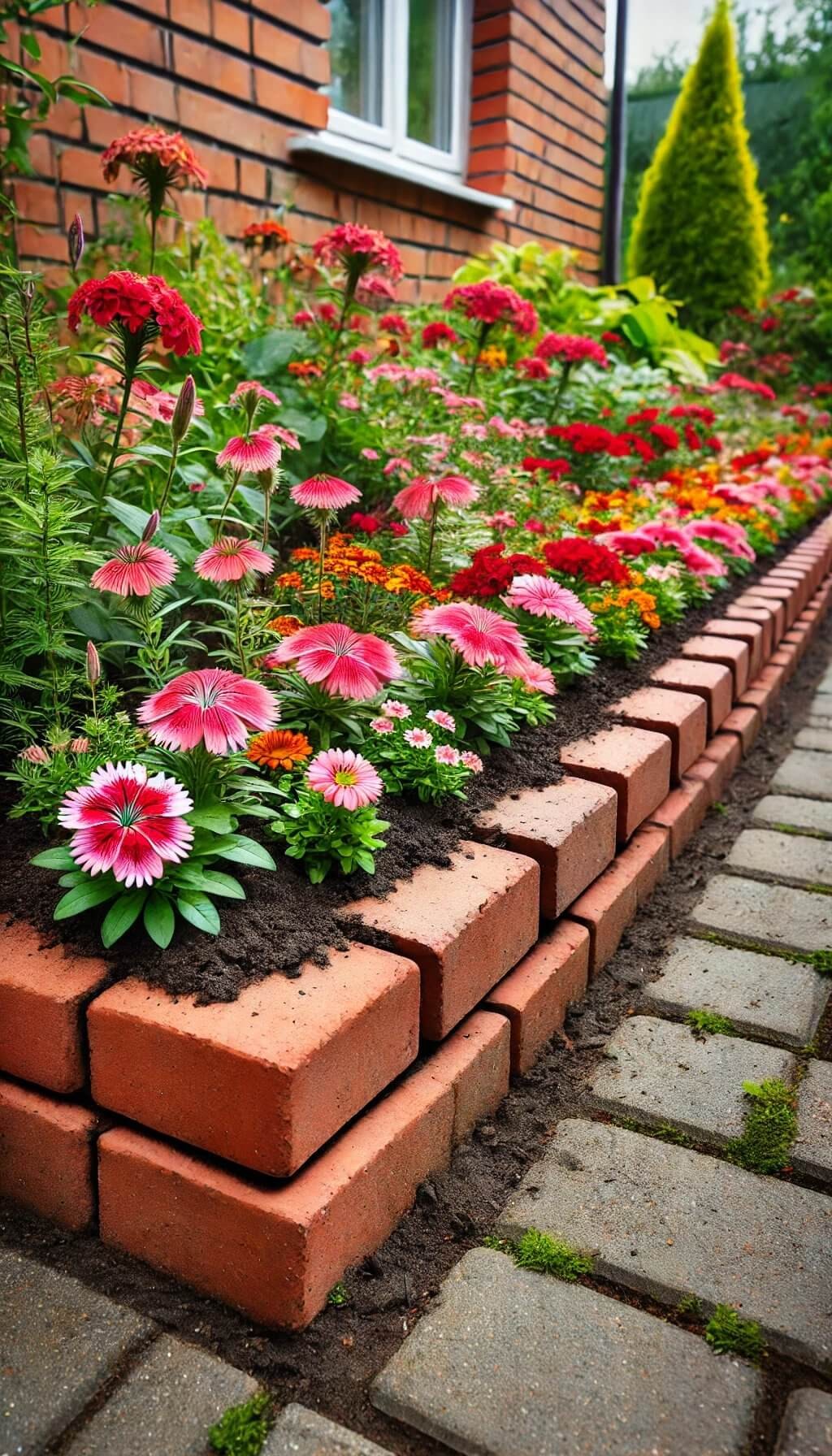
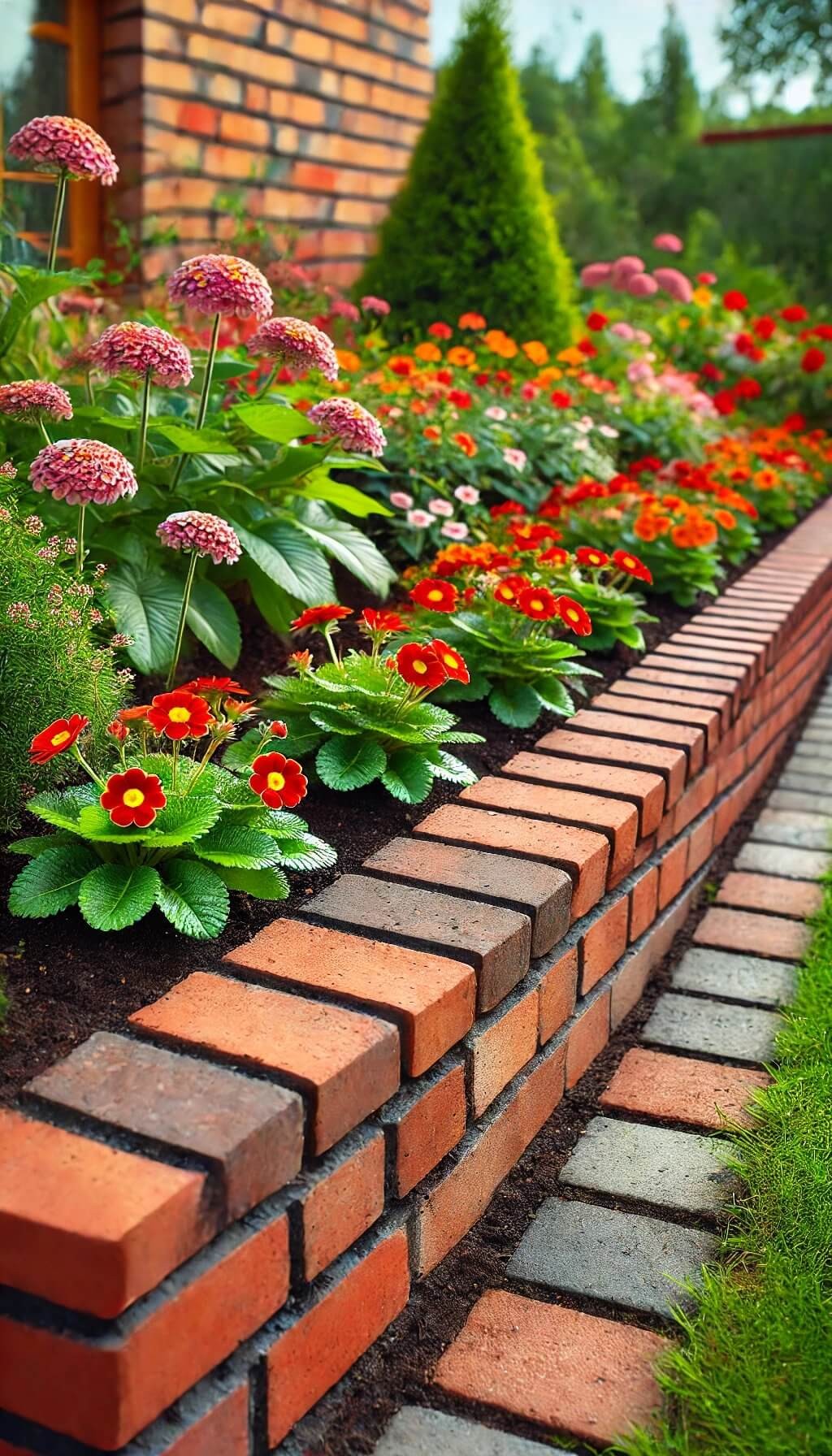
Transform your outdoor space with a unique and thriving border! Consider combining traditional brick edging with charming flower inserts. Design your brick pattern as you like it, leaving room for a layer of soil and small blooms between each section. This clever combination will yield not only a sturdy and practical edge but also a visually stunning display of colorful flowers that attract butterflies and bees.
To maintain the vibrancy of your border, select flowers that have a natural tendency to spread, effectively covering any exposed soil and keeping your edging lively and engaging.
Brick Edging with Lighting
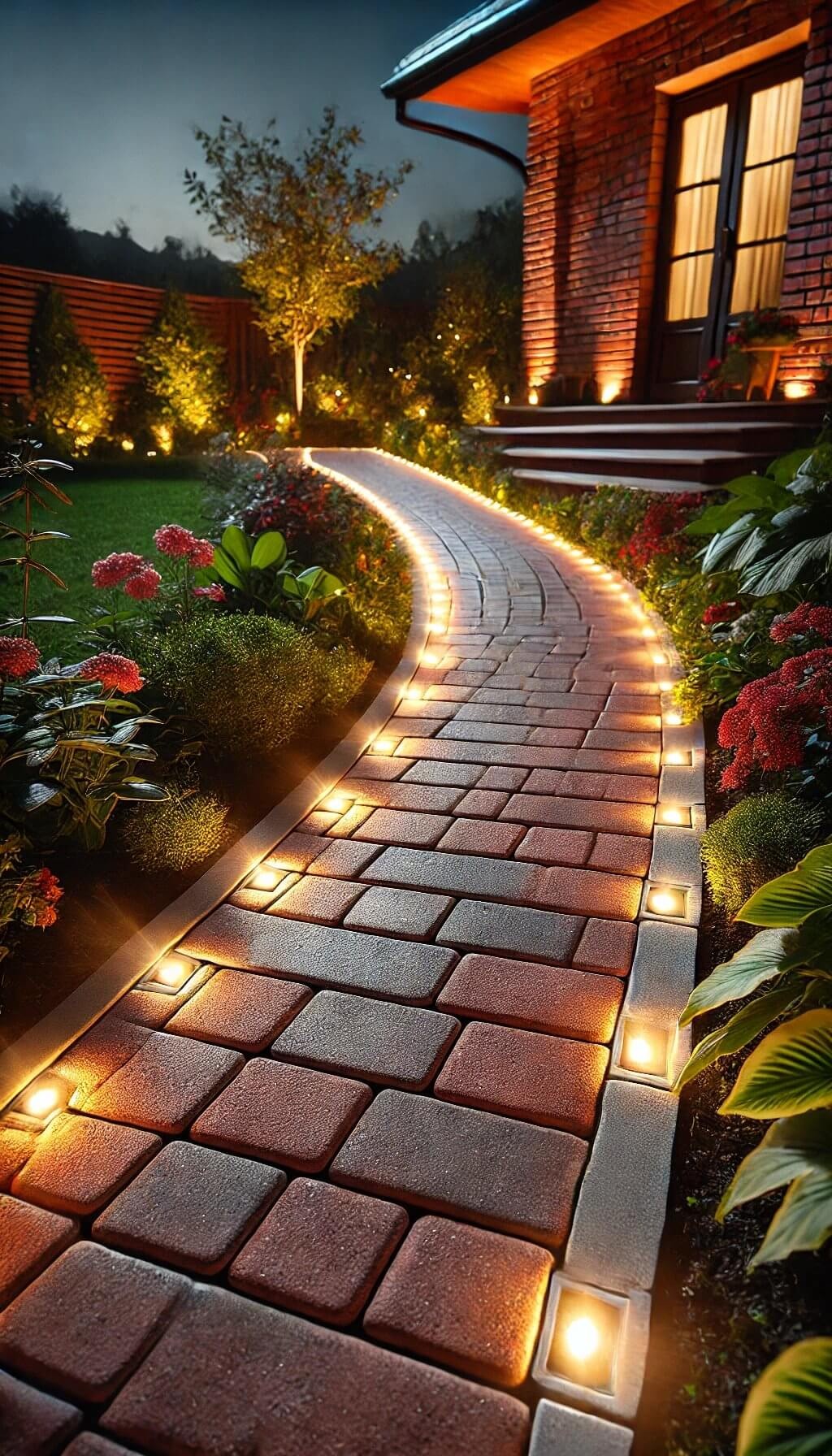
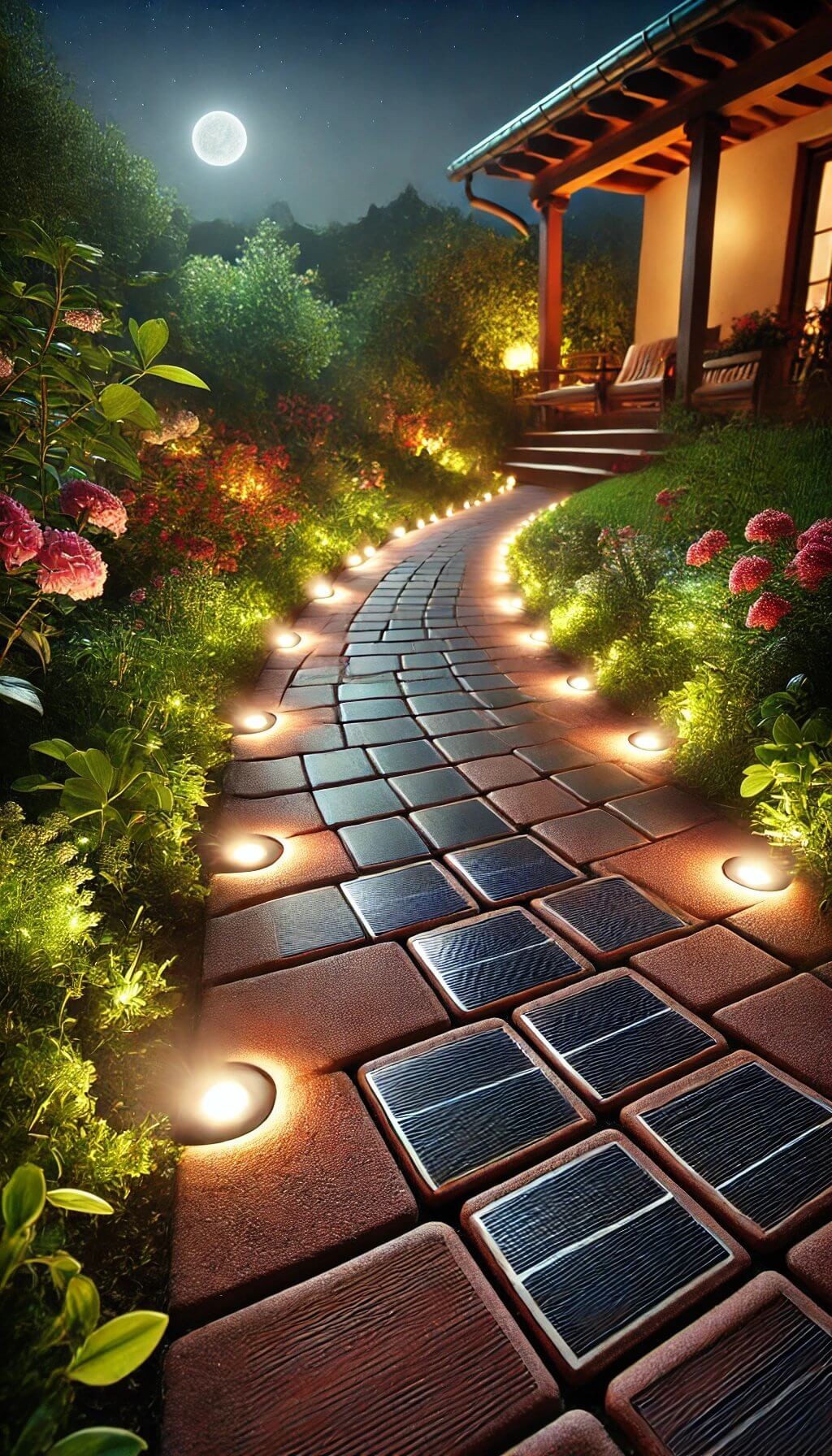
Transform your garden paths into warm and welcoming spaces by incorporating brick edging with lighting. This stylish approach isn’t just about ensuring safety after dark, it’s also about creating a captivating ambiance. To achieve this, consider using low-voltage LED lights or solar-powered options for an eco-conscious touch. Installation is straightforward, as long as you lay the cables beforehand and set the bricks in place.
By doing so, you’ll not only create inviting garden paths but also provide a safe and well-lit environment for evening strolls.
Mosaic Brick Edging
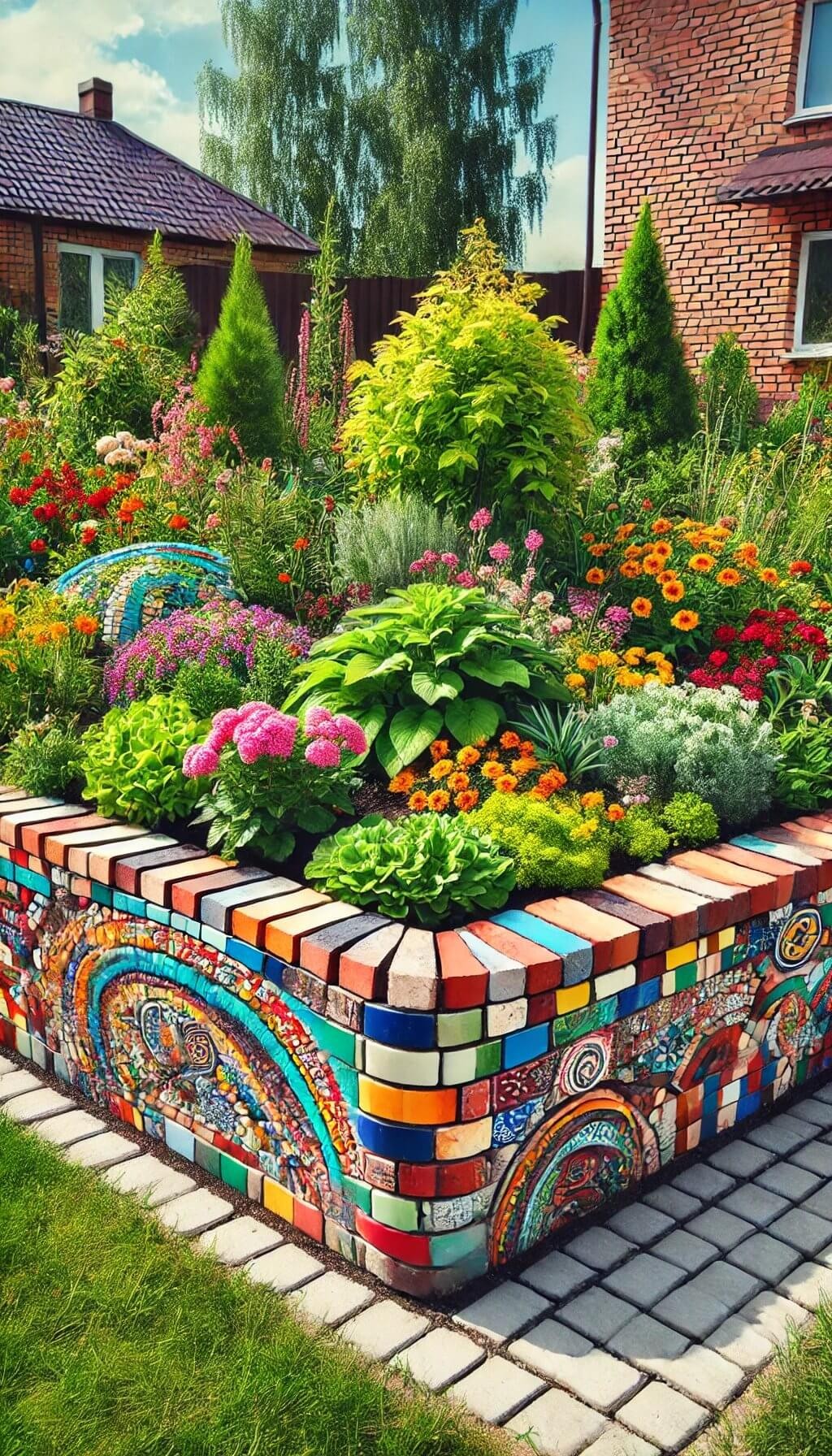

Unleash your creativity by transforming mosaic brick edging into a work of art! This isn’t just about laying bricks; it’s an opportunity to create a stunning visual display. Select various colors and break them down into individual pieces, carefully designing each element to fit seamlessly into your overall composition. The process is akin to solving a puzzle, with the satisfaction of seeing your masterpiece take shape.
By following a straightforward step-by-step approach – laying out your design, applying mortar to hold it all together, and filling in any gaps – you’ll be left with a border that’s not only visually striking but also remarkably resilient.
Brick Edging with Metal Accents
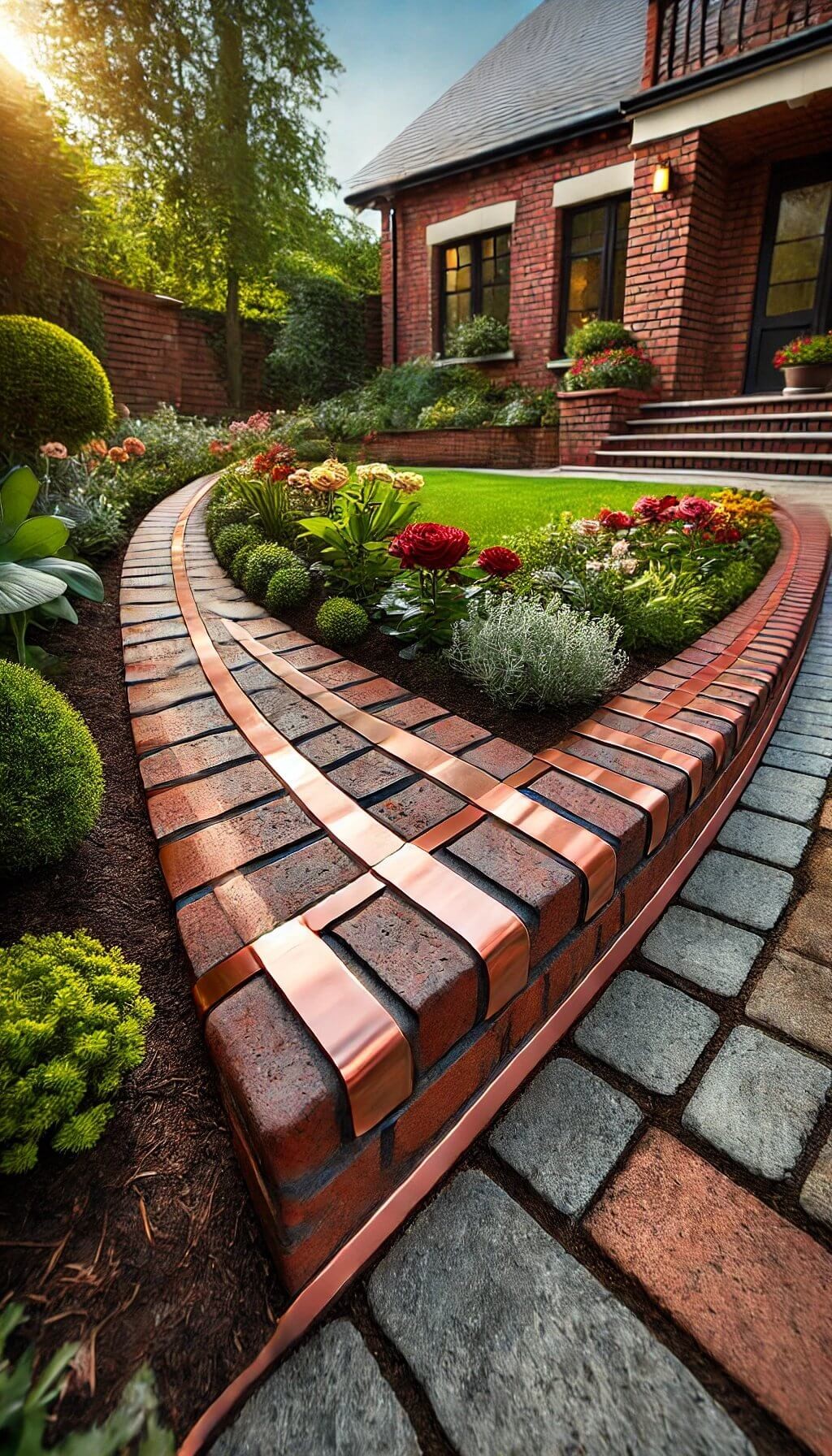
Combine bricks with metallic accents for a sleek, industrial-inspired garden design. Incorporate copper or steel strips between bricks to create a striking visual effect that shines when the sun hits. This aesthetic choice also serves a practical purpose – the metal helps keep the bricks in place, reducing the risk of shifting or falling over time. To achieve this look, embed metal strips into the mortar during installation and treat them with rust inhibitors to maintain their shine.
The result is a garden that’s both tough and visually appealing.
Brick Edging for Pathways


A well-designed pathway is the perfect way to guide visitors through your beautiful garden. One effective way to achieve this is by using brick edging, which not only keeps your walkways tidy and defined but also adds a touch of elegance to your outdoor space. By laying bricks flat or angling them for a more dynamic look, you can create a visually appealing pathway that draws the eye and encourages exploration.
The process of installation is surprisingly straightforward: simply dig a trench, lay your bricks in place, and backfill with soil or gravel. While it may seem like a simple task, the impact it has on the overall aesthetic of your garden cannot be overstated.
Multi-level Brick Edging

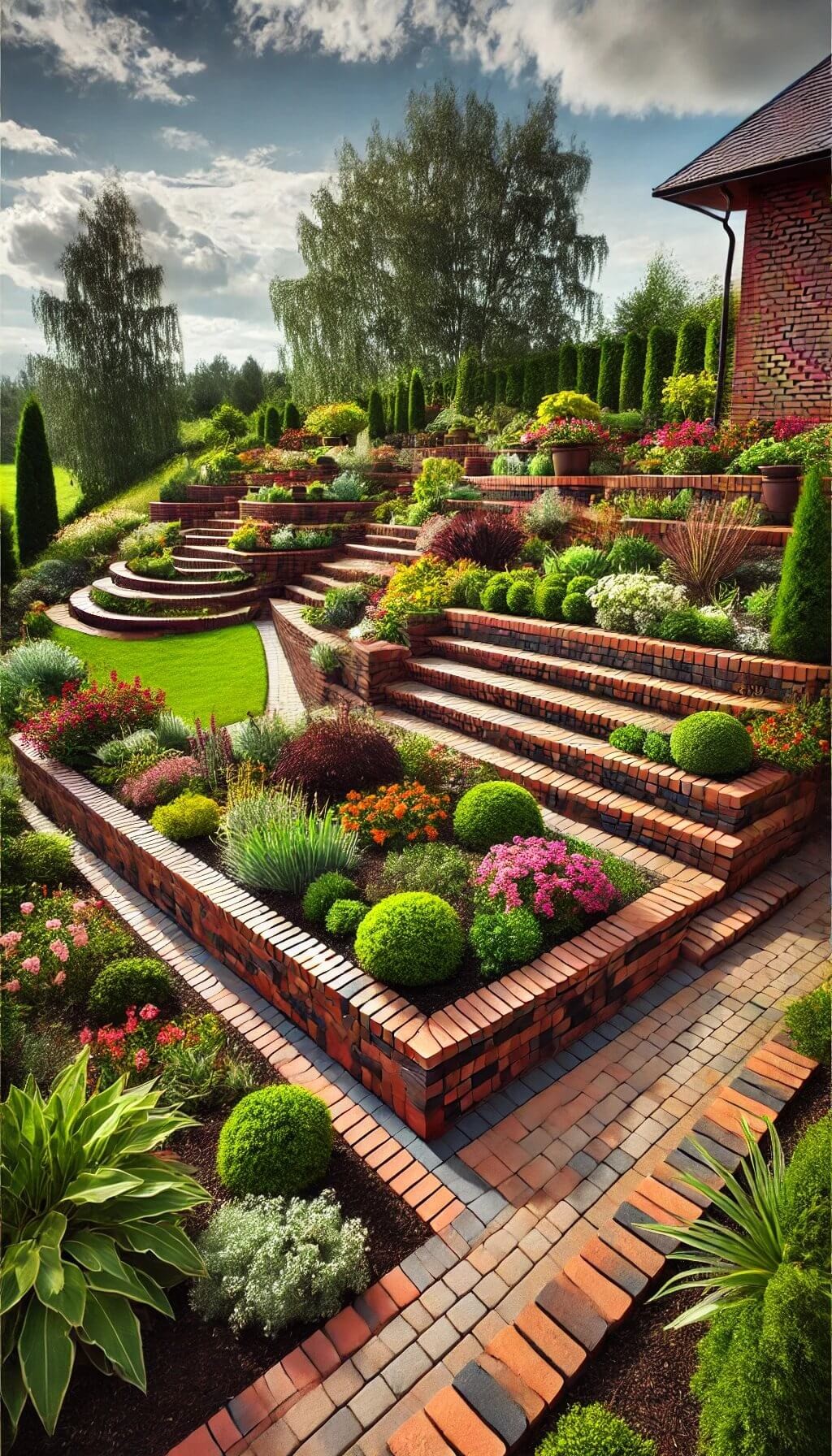
When creating multi-level brick edging, it’s not just about defining garden beds, but rather crafting a visually appealing landscape with depth and complexity. This technique is particularly effective in gardens featuring slopes or varying elevations, where it can help to mitigate soil erosion and showcase plants at different heights. To achieve this look, build the edging in tiered or stepped sections, ensuring each level is securely supported and stable to prevent shifting or collapse.
The result is a transformed garden that adds an extra layer of interest and visual appeal.
Brick Edging for Water Features
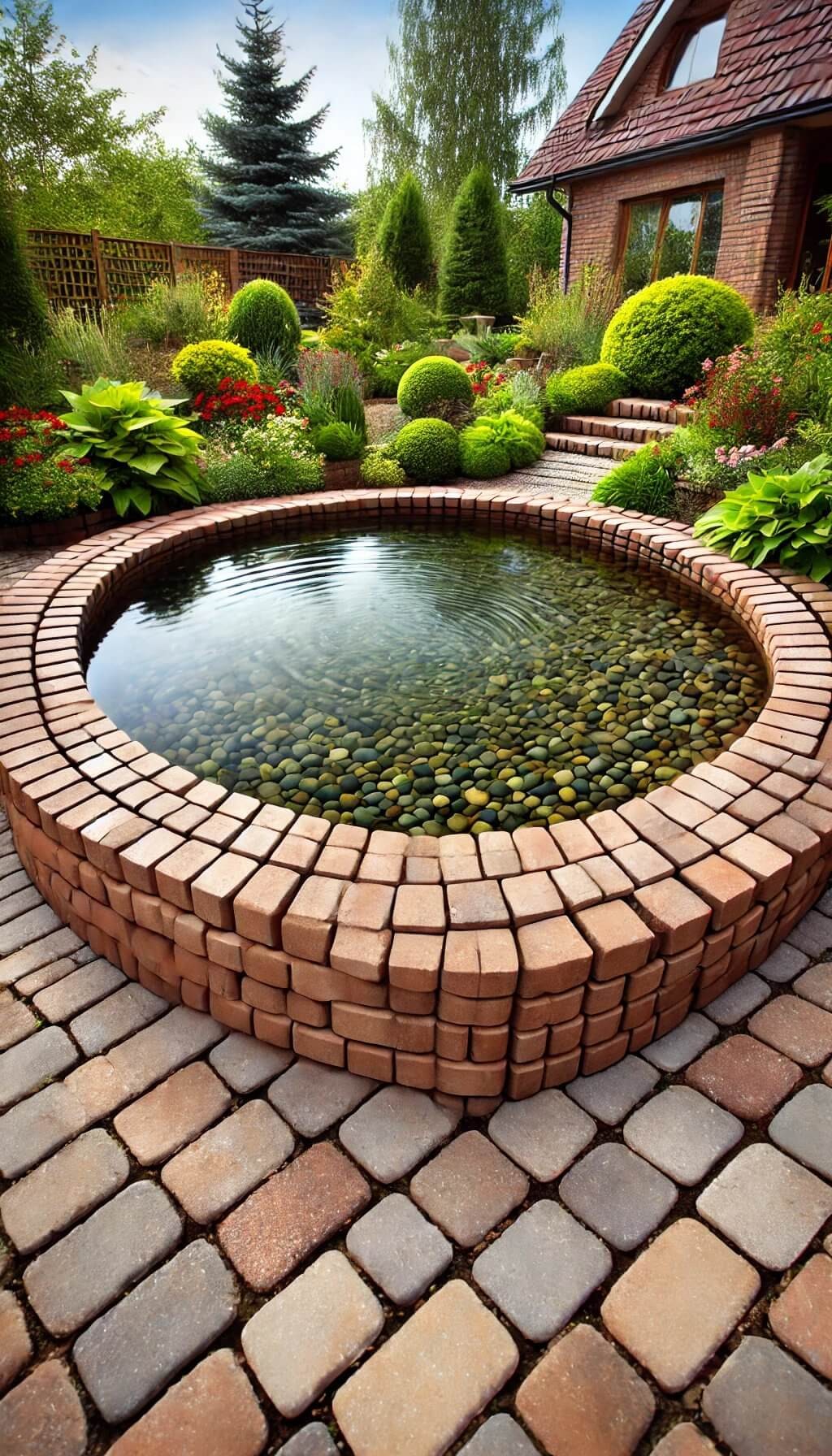
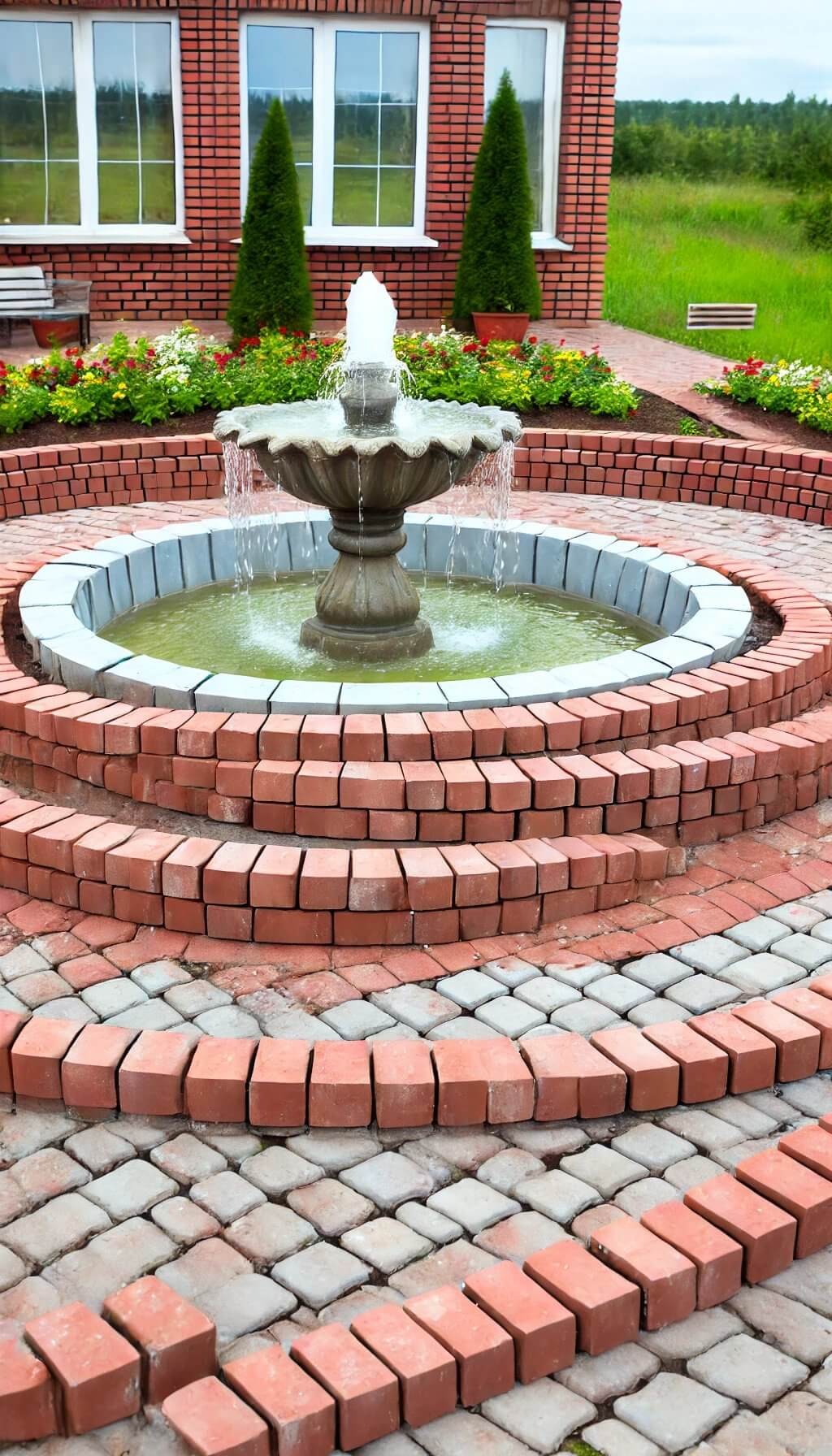
Consider brick edging as a brushstroke that completes your water feature masterpiece. Whether you’re encircling a serene pond or framing a lively fountain, carefully selected bricks can elevate the entire scene. To ensure a safe and inviting environment, make sure the bricks are securely fastened and level to prevent tripping hazards. Choose weather-resistant materials to maintain the charm throughout the year.
This edging not only enhances the visual appeal of water elements but also harmoniously integrates them into the surrounding landscape.
Rustic Brick Edging

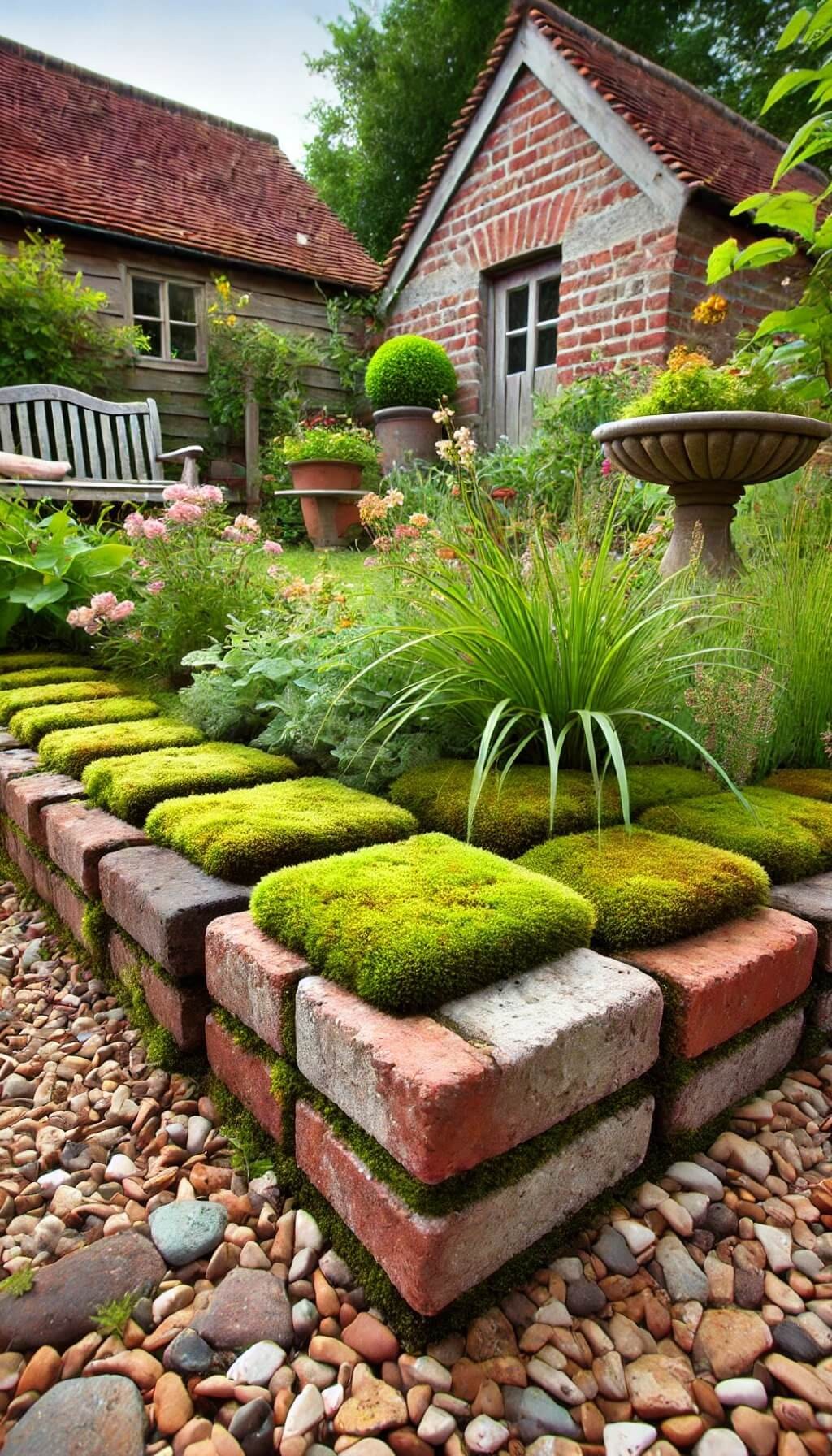
For an authentic touch of vintage charm, consider incorporating weathered or reclaimed brick edging into your design. This timeless style boasts a cozy, lived-in feel that seems to have been there forever, evoking the warmth and character of a bygone era. Suitable for cottage gardens, rustic landscapes, or any setting seeking to evoke a sense of nostalgia, this look can be achieved through loose laying or deliberate gaps filled with lush moss.
To maintain its rustic allure, regular inspections will ensure that natural wear and shifting are addressed, preserving the endearing charm that makes it a timeless choice.
Conclusion
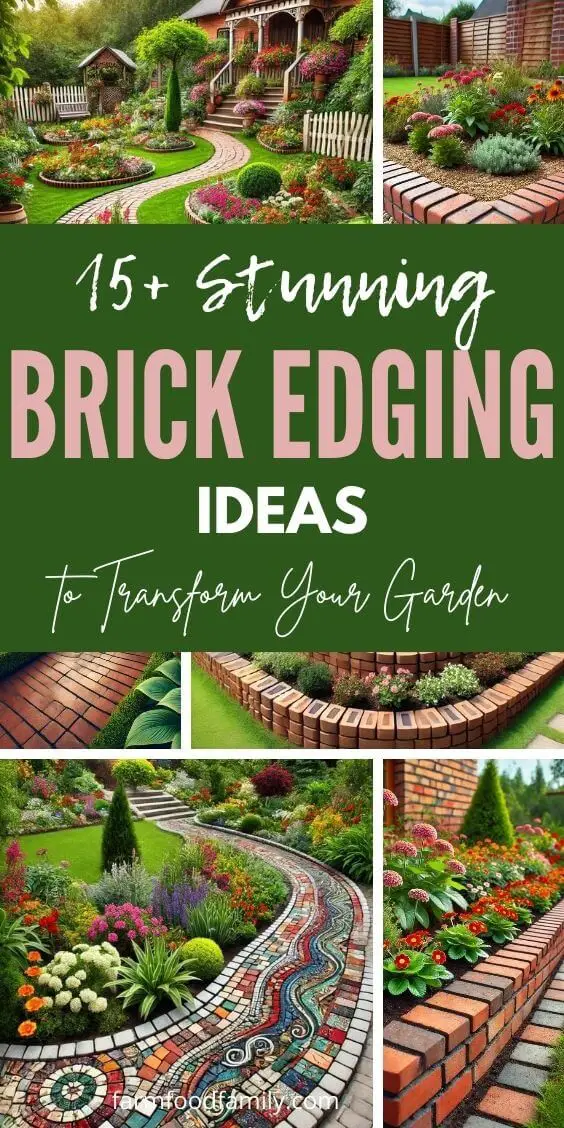
As you conclude your outdoor oasis makeover, it’s clear that each of these brick edging ideas brings a unique touch to your garden’s aesthetic and functionality. From creating dynamic layered looks to defining tranquil water features or infusing rustic charm with distressed bricks, there’s an edging style that harmonizes with every garden theme and requirement.
These creative techniques not only enhance the visual appeal but also offer practical benefits such as soil stabilization and path definition. So, gather your materials, tap into your imagination, and turn your garden into a stunning work of art that embodies your personal flair and landscaping philosophy. Happy gardening!
FAQs about Brick Edging
What are the best types of bricks for garden edging?
When it comes to selecting brick types for garden edging, your personal taste and the overall aesthetic of your outdoor space play crucial roles. For a low-maintenance option that can withstand the elements, consider weather-resistant bricks like fired clay or concrete. These materials are designed to endure exposure to rain, sun, and other forms of weathering without compromising their appearance.
On the other hand, if you’re aiming for a unique, rustic charm, reclaimed or antique bricks might be the perfect choice, allowing you to incorporate an element of vintage character into your garden’s design.
How do I install brick edging in my garden?
To install brick edging, you’ll need to start by digging a trench that’s approximately 4-6 inches deep and as wide as the bricks themselves. This will provide a solid foundation for your edging. Next, lay down a base layer of sand or gravel to ensure proper drainage and stability. Once this is in place, begin laying the bricks tightly together, making sure to maintain even spacing throughout. Finally, backfill with soil to secure the bricks in their new position.
For curved lines, consider opting for flexible brick types that can be adjusted to fit your desired shape. These will provide a seamless transition and add a touch of sophistication to your outdoor space.
Can brick edging help with soil erosion in my garden?
Effective soil erosion management is just one of the many benefits that brick edging can provide. By creating a sturdy barrier at the perimeter of garden beds, this technique prevents excessive soil loss due to heavy rainfall, while also keeping mulch in place and preserving the overall aesthetic appeal of your outdoor landscape.
What maintenance is required for brick garden edging?
When it comes to maintenance for brick garden edging, a thorough inspection is essential to identify any issues that may have arisen since its installation. This involves checking for loose or shifted bricks, as well as weeding between them to prevent the growth of unwanted vegetation. Additionally, a periodic cleaning of the bricks is necessary to remove dirt and moss that can accumulate over time.
Furthermore, sealing the bricks every few years can help preserve their original color and protect them from weather damage, ensuring they continue to look their best for years to come.
Are there eco-friendly options for brick edging?
When it comes to eco-friendly landscaping solutions, consider incorporating reclaimed or recycled bricks into your garden design, specifically for edging purposes. This sustainable approach not only preserves the natural environment but also maintains a visually appealing and functional edge. Furthermore, opting for local materials significantly minimizes the carbon impact stemming from transportation, making it an environmentally conscious decision.






